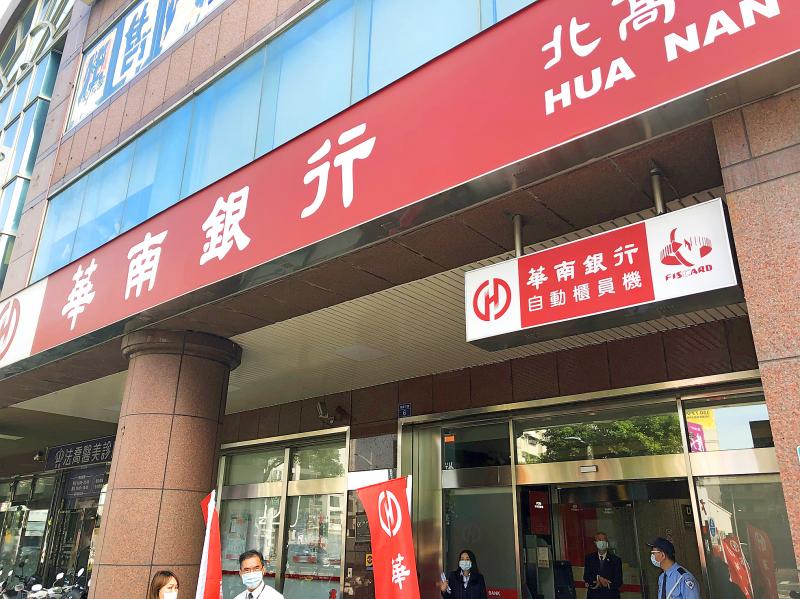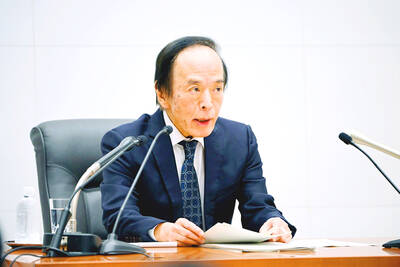State-run Hua Nan Commercial Bank (華南銀行) yesterday said that it is to recruit information technology personnel to meet development needs, as technology is reshaping the banking industry and it is stepping up digital transformation to stay competitive.
The century-old bank said it is in need of specialists in Java programming, software development, project management and systems integration training.
Nearly 70 percent of corporations have assigned more importance to information technology talent in the post-COVID-19 period, with the percentage reaching a high 86 percent among financial institutions, Hua Nan said, citing a survey of chief information officers by technology Web site iThome.

Photo: Kelson Wang, Taipei Times
Hua Nan welcomes jobseekers displaced or affected by the COVID-19 outbreak to join the company by following recruitment tips on its Web site and that of online recruitment agencies.
The lender’s information management business has three subdivisions that take charge of information security, information services, and information planning and development, it said.
New colleagues have the opportunity to sharpen their professional skills and knowhow on front-desk operations, back-
office efficiency enhancement, and cross-sectional coordination and integration, in line with their interests and strengths, it said.
To attract information technology talent, the lender said it has ditched its conventional seniority-focused promotion mechanism and replaced it with a system that values performance records and certificate accumulation.
Hua Nan said it has raised wages by at least 3 percent a year, with employees’ annual compensation averaging about 18.8 months of their monthly pay.

Taiwan’s long-term economic competitiveness will hinge not only on national champions like Taiwan Semiconductor Manufacturing Co. (TSMC, 台積電) but also on the widespread adoption of artificial intelligence (AI) and other emerging technologies, a US-based scholar has said. At a lecture in Taipei on Tuesday, Jeffrey Ding, assistant professor of political science at the George Washington University and author of "Technology and the Rise of Great Powers," argued that historical experience shows that general-purpose technologies (GPTs) — such as electricity, computers and now AI — shape long-term economic advantages through their diffusion across the broader economy. "What really matters is not who pioneers

In a high-security Shenzhen laboratory, Chinese scientists have built what Washington has spent years trying to prevent: a prototype of a machine capable of producing the cutting-edge semiconductor chips that power artificial intelligence (AI), smartphones and weapons central to Western military dominance, Reuters has learned. Completed early this year and undergoing testing, the prototype fills nearly an entire factory floor. It was built by a team of former engineers from Dutch semiconductor giant ASML who reverse-engineered the company’s extreme ultraviolet lithography (EUV) machines, according to two people with knowledge of the project. EUV machines sit at the heart of a technological Cold

TAIWAN VALUE CHAIN: Foxtron is to fully own Luxgen following the transaction and it plans to launch a new electric model, the Foxtron Bria, in Taiwan next year Yulon Motor Co (裕隆汽車) yesterday said that its board of directors approved the disposal of its electric vehicle (EV) unit, Luxgen Motor Co (納智捷汽車), to Foxtron Vehicle Technologies Co (鴻華先進) for NT$787.6 million (US$24.98 million). Foxtron, a half-half joint venture between Yulon affiliate Hua-Chuang Automobile Information Technical Center Co (華創車電) and Hon Hai Precision Industry Co (鴻海精密), expects to wrap up the deal in the first quarter of next year. Foxtron would fully own Luxgen following the transaction, including five car distributing companies, outlets and all employees. The deal is subject to the approval of the Fair Trade Commission, Foxtron said. “Foxtron will be

INFLATION CONSIDERATION: The BOJ governor said that it would ‘keep making appropriate decisions’ and would adjust depending on the economy and prices The Bank of Japan (BOJ) yesterday raised its benchmark interest rate to the highest in 30 years and said more increases are in the pipeline if conditions allow, in a sign of growing conviction that it can attain the stable inflation target it has pursued for more than a decade. Bank of Japan Governor Kazuo Ueda’s policy board increased the rate by 0.2 percentage points to 0.75 percent, in a unanimous decision, the bank said in a statement. The central bank cited the rising likelihood of its economic outlook being realized. The rate change was expected by all 50 economists surveyed by Bloomberg. The